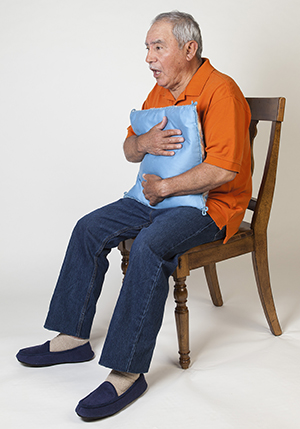A
B
C
D
E
F
G
H
I
J
K
L
M
N
O
P
Q
R
S
T
U
V
W
X
Y
Z
Topic IndexLibrary Index
Click a letter to see a list of conditions beginning with that letter.
Click 'Topic Index' to return to the index for the current topic.
Click 'Library Index' to return to the listing of all topics.
Deep Coughing
Deep coughing helps keep your lungs clear. If you’ve had surgery, this will help you get better faster. Deep coughing also helps you breathe easier and may prevent a lung infection or other complications. Follow these steps to do deep coughing.

Step 1
-
Sit on the edge of a bed or a chair. You can also lie on your back with your knees slightly bent.
-
Lean forward slightly.
-
If you've had surgery on your chest or stomach, hold a pillow or rolled-up towel firmly against your cut (incision) with both hands. Hug the pillow.
-
Breathe out normally.
Step 2
-
Breathe in slowly and deeply through your nose.
-
Then breathe out fully through your mouth. Repeat this breathing in and out a second time.
-
For the third time, take a slow, deep breath through your nose. Fill your lungs with as much air as you can.
Step 3
-
Cough 2 or 3 times in a row. Try to push all of the air out of your lungs as you cough. Cover your cough, if possible, with a tissue or your elbow.
-
If you cough up mucus, spit it into a tissue. Don't swallow it.
-
Relax and breathe normally.
-
Repeat the above steps as directed.
-
Wash your hands with soap and clean, running water for 20 seconds afterward.
Follow-up care
Follow up with your healthcare provider, or as advised.
When to call your healthcare provider
Call your healthcare provider right away if you have any of the following:
-
Fever of 100.4°F (38°C) or higher, or as advised by your provider
-
Signs of infection, if you've had surgery. These include redness, swelling, drainage, or warmth at your incision site, or pus or fluid draining from the site
-
Minor bleeding from surgical site
-
Brownish, white, or bloody sputum
-
Upset stomach (nausea) or vomiting
-
More pain
-
Fast or irregular heartbeat
-
New cough
Call 911
Shortness of breath may be a sign of a serious health problem. Call 911right away if you have shortness of breath that gets worse or you have trouble breathing, especially with any of the symptoms below:
-
Confusion or trouble staying awake
-
Loss of consciousness or fainting
-
Chest pain or tightness
-
Trouble breathing or wheezing
-
Skin, lips, or fingernails turn blue
-
Coughing up blood
-
Severe pain
-
Dizziness or weakness
-
Severe bleeding or new opening at surgical site
Online Medical Reviewer:
Deborah Pedersen MD
Online Medical Reviewer:
Jessica Gotwals BSN MPH
Online Medical Reviewer:
Marianne Fraser MSN RN
Date Last Reviewed:
6/1/2022
© 2000-2025 The StayWell Company, LLC. All rights reserved. This information is not intended as a substitute for professional medical care. Always follow your healthcare professional's instructions.